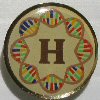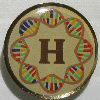
 Charles Kerchner's
Charles Kerchner's
MtDNA Haplogroup Descriptions & Information Links
The following mtDNA Haplogroup Descriptions are from the FamilyTreeDNA.com website which was the
testing company used to determine the nearest Haplogroup assigment based on the individual's
haplotype results from the mtDNA maternal line test. These verbatim Haplogroup Descriptions and/or excerpts
are copyrighted by FamilyTreeDNA.com and all rights to these descriptions are claimed by FamilyTreeDNA.com.
These descriptions have been printed here with the permission of FamilyTreeDNA.com. These
descriptions cannot be used elsewhere without the written permission
of FamilyTreeDNA.com.
Personalized names were given to seven common European mtDNA haplogroups by Bryan Sykes in his book, "The Seven Daughters of Eve".
Kerchner's Haplogroup vs. Haplotype - What is the Difference Report
MtDNA Test Results Log and Database
Check out the MtDNA Haplogroup Pins
See the Genetic Genealogy DNA Testing Dictionary
Jump to Y-DNA Haplogroup Descriptions Page
mtDNA Haplogroup Migration Map from FTDNA (2006)
Specific mitochondrial haplogroups are typically found in different regions of the world, and this is due to unique population histories. In the process of spreading around the world, many populations—with their special mitochondrial haplogroups—became isolated, and specific haplogroups concentrated in geographic regions. Today, we have identified certain haplogroups that originated in Africa, Europe, Asia, the islands of the Pacific, the Americas, and even particular ethnic groups. Of course, haplogroups that are specific to one region are sometimes found in another, but this is due to recent migration.
A, B, C, & D: Haplogroups A, B, C, & D. Native American mtDNA Haplogroups. Also see mtDNA Haplogroup X.
Clan Aiyana Home Page by Amelia
mtDNA Haplogroup A (Clan Aiyana) by Blaine Bettinger
Native American Lineage and mtDNA Haplogroups Yahoo Group
MtDNA Haplogroup B Project by Ernie Alderete
F: Mitochondrial haplogroup F Information.
The Evidence of mtDNA Haplogroup F in a European Population and its Ethnohistoric Implications
MtDNA Haplogroup F Wiki Page
H: Mitochondrial haplogroup H is a predominantly European haplogroup that participated in a population expansion beginning approximately 20,000 years ago. Today, about 30% of all mitochondrial lineages in Europe are classified as haplogroup H. It is rather uniformly distributed throughout Europe suggesting a major role in the peopling of Europe, and descendant lineages of the original haplogroup H appear in the Near East as a result of migration. Future work will better resolve the distribution and historical characteristics of this haplogroup. Bryan Sykes in his Seven Daughters of Eve book named this mtDNA haplogroup Helena.
Amelia Reimer's Clan Helena Website
Rebekah's mtDNA Haplogroup H Project
Cyndi Rutledge and Peter Roberts mtDNA Haplogroup H1 Project
Ages for Subclades of mtDNA Haplogroup H
HV: Mitochondrial haplogroup HV is a primarily European haplogroup that underwent an expansion beginning approximately 20,000 years ago. It is more prevalent in western Europe than in eastern Europe, and descendant lineages of the original haplogroup HV appear in the Near East as a result of more recent migration. One of the dominant mitochondrial haplogroups in Europe, haplogroup HV pre-dates the occurrence of farming in Europe. Future work will better resolve the distribution and historical characteristics of this haplogroup.
Ian Logan's Haplgroup HV and V Webpage
I: Principally a European haplogroup, haplogroup I is detected at very low frequency across west Eurasia with slightly greater representation in northern and western Europe. Given its wide, but sparse, distribution, it is likely that it was present in those populations that first colonized Europe. This hypothesis is supported by the estimate its age—approximately 30,000 years. Bonnie Schrack in her mtDNA Haplogroup I project named this mtDNA haplogroup Iris.
Bonnie Schrack's Clan Iris Website
J*: The mitochondrial haplogroup J contains several sub-lineages. The original haplogroup J originated in the Near East approximately 50,000 years ago. Within Europe, sub-lineages of haplogroup J have distinct and interesting distributions. Haplogroup J* — the root lineage of haplogroup J — is found distributed throughout Europe, but at a relatively low frequency. Haplogroup J* is generally considered one of the prominent lineages that was part of the Neolithic spread of agriculture into Europe from the Near East beginning approximately 10,000 years ago.
Bryan Sykes in his Seven Daughters of Eve book named this mtDNA haplogroup Jasmine.
Sharon Bryant's mtDNA Haplogroup J* Project
John Walden's Haplogroups J and K Website
J1b1: The mitochondrial haplogroup J contains several sub-lineages. The original haplogroup J originated in the Near East approximately 50,000 years ago. Within Europe, sub-lineages of haplogroup J have distinct and interesting distributions. Haplogroup J1b is found distributed in the Near East and southern Iberia, and may have been part of the original colonization wave of Neolithic settlers moving around the Mediterranean 6000 years ago or perhaps a lineage of Phoenician traders. Within haplogroup J1b, a derivative lineage haplogroup J1b1 has been found in Britain and another sub-lineage detected in Italy. Further research will better establish the relationship of these two geographically distant, yet evolutionarily related, haplogroups.
Bryan Sykes in his Seven Daughters of Eve book named this mtDNA haplogroup Jasmine.
Jim Logan's mtDNA Haplogroup J1 Project
John Walden's Haplogroups J and K Website
K: The mitochondrial super-haplogroup U encompasses haplogroups U1-U7 and haplogroup K. Haplogroup K is found through Europe, and contains multiple closely related lineages indicating a recent population expansion. The origin of haplogroup K dates to approximately 16,000 years ago, and it has been suggested that individuals with this haplogroup took part in the pre-Neolithic expansion following the Last Glacial Maximum.
Bryan Sykes in his Seven Daughters of Eve book named this mtDNA haplogroup Katrine.
Bill Hurst's mtDNA Haplogroup K Project
John Walden's Haplogroups J and K Website
L1: Haplogroup L1 is found in West and Central sub-Saharan Africa. Some of its branches (L1d, L1k, L1a, L1f) were
recently re-classified into haplogroup L0 as L0d, L0k, L0a and L0f. Haplogroup L1 arose with Mitochondrial Eve and
haplogroup L0 is an offshoot. The descendants of haplogroup L1 are also African haplogroups L2 and L3, the latter of which
gave rise to all non-African haplogroups. Haplogroup L1 is believed to have first appeared in
Africa approximately 150,000 to 170,000 years ago.
L2: Haplogroup L2 is native to sub-Saharan Africa, where it is present in approximately one third of all
people. It is believed to have arisen approximately 70,000 years ago from the line of haplogroup L1.
L3: Haplogroup L3 is confined to Africa and emigrant African populations. It is most common in East Africa.
However, L3 is also the haplogroup from which the macro-haplogroups M and N are believed to have arisen.
These two haplogroups are ancestral to all haplogroups outside Africa, and are believed to represent the
initial migration by modern humans out of Africa.
M: Haplogroup M cluster has been characterized as generally of east Eurasia—a geographic region that includes south Asia, east Asia, and Australasia. One of the two deep roots of the mitochondrial tree of haplogroups found in Asia, haplogroup M dates to approximately 70,000 years ago. Interestingly, one of the sub-haplogroups of the M cluster, haplogroup M1, is found primarily in northern Africa, suggesting either a very early divergence from the root of haplogroup M or even migration back to Africa after the original dispersal into Eurasia. Future work will further document the historical distribution of this root haplogroup and closely related haplogroups within the M cluster.
MtDNA Haplogroup M at FamilyTreeDNA
N: Haplogroup N. The N superhaplogroup has been characterized as pan-Eurasian. Haplogroup N is one of the two major trunks emerging from the original African root, and dates to approximately 65,000 years ago. Interestingly, several sub-haplogroups of the N cluster—haplogroup N1 and derivative lineages—have been detected in the Near East, suggesting either early divergence near the root of haplogroup N or subsequent migrations back towards western Eurasia following the original dispersal into east Eurasia. Future work will further document the historical distribution of this root haplogroup and closely related haplogroups within the N cluster.
Ian Logan's mtDNA Haplogroup N Webpage
N1c: N1c specific mitochondrial haplogroups are typically found in different regions of the world, and this is due to unique population histories. In the process of spreading around the world, many populations—with their special mitochondrial haplogroups—became isolated, and specific haplogroups concentrated in geographic regions. Today, we have identified certain haplogroups that originated in Africa, Europe, Asia, the islands of the Pacific, the Americas, and even particular ethnic groups. Of course, haplogroups that are specific to one region are sometimes found in another, but this is due to recent migration.
T: Haplogroup T is believed to have lived around 17,000 years ago in Nothern Italy. Tara's people would have come from the Near East, and her descendents spread all over Europe.
Bryan Sykes in his Seven Daughters of Eve book named this mtDNA haplogroup Tara.
Felice Bedford's Clan Tara Results Discussion Webpage
Phylogenetic Networks for the Human mtDNA Haplogroup T by David A. Pike
T1: MtDNA Haplogroup T1 Project
U2: Mitochondrial haplogroup U2.
Cyndi Rutledge's mtDNA Haplogroup U2 Project
U5: The mitochondrial super-haplogroup U encompasses haplogroups U1-U7 and haplogroup K. Haplogroup U5, with its own multiple lineages nested within, is the oldest European-specific haplogroup, and its origin dates to approximately 50,000 years ago. Most likely arising in the Near East, and spreading into Europe in a very early expansion, the presence of haplogroup U5 in Europe pre-dates the expansion of agriculture in Europe. Haplogroup U5a1—a lineage within haplogroup U5—arose in Europe approximately 30,000 years ago, and is mainly found in northwest Europe. In the context of its rather ancient origin, the modern distribution of haplogroup U5a1 suggests that individuals bearing this haplogroup were part the initial expansion tracking the retreat of ice sheets from Europe. Bryan Sykes in his Seven Daughters of Eve book named this mtDNA haplogroup Ursula.
Brian Hamman's Clan Ursula (U5 sub-group) Website
MtDNA Haplogroup U5 Webpage at WorldFamilies.net
U6: The mitochondrial super-haplogroup U encompasses haplogroups U1-U7 and haplogroup K. Bryan Sykes in his Seven Daughters of Eve book named this mtDNA haplogroup Ursula.
Dave Strong's Clan Ursula (U6 sub-group) Website
U7: The mitochondrial super-haplogroup U encompasses haplogroups U1-U7 and haplogroup K. Haplogroup U7 has a Near Eastern origin approximately 30,000 years ago. Within Europe, it occurs at low frequency in the Caucasus. Bryan Sykes in his Seven Daughters of Eve book named this mtDNA haplogroup Ursula.
MtDNA Haplogroup U7 Project at FTDNA
V: Bryan Sykes in his Seven Daughters of Eve book named this mtDNA haplogroup Velda.
http://en.wikipedia.org/wiki/Haplogroup_V_(mtDNA)
W: Haplogroup W is a "daughter" of N and a "sister" of R, I, X, & A.
Mary Zucker's mtDNA Haplogroup W Project
X: Haplogroup X is found in Europe and Asia, and is believed to have migrated to the Americas about 15,000 years ago, making up a very small component of the Native American population.
Bryan Sykes in his Seven Daughters of Eve book named this mtDNA haplogroup Xenia.
Carolyn Benson's mtDNA Haplogroup X Project at FTDNA
A 2003 scientific paper by Reidla, et al, on the Origins and Diffusion of mtDNA Haplogroup X.
A 1998 scientific paper by Michael Brown, et al: mtDNA Haplogroup X: An Ancient Link between Europe/Western Asia and North America?

 Y-DNA Haplogroup Descriptions
Y-DNA Haplogroup Descriptions
MtDNA Test Results Log and Database
Order a MtDNA Haplogroup Pin
Order a Genetic Genealogy DNA Testing Dictionary
Kerchner's DNA Testing & Genetic Genealogy Info and Resources Page
Copyright ©2003-2012
3
Charles F. Kerchner, Jr.
All Rights Reserved
Created - 6 Jun 2003
Updated - 13 Nov 2013

 Charles Kerchner's
Charles Kerchner's